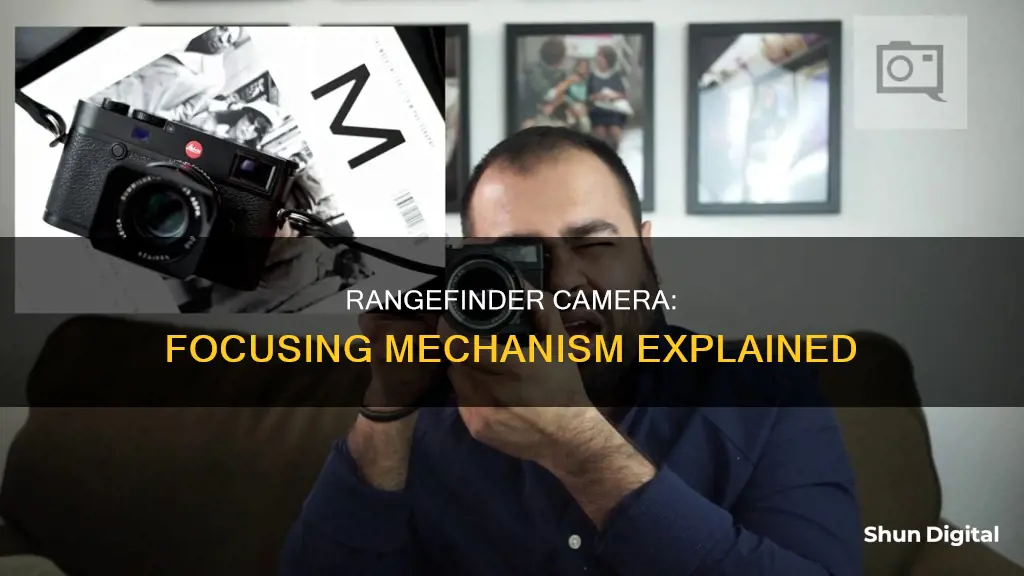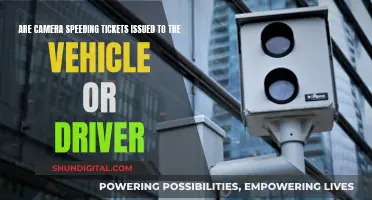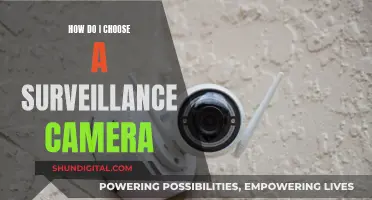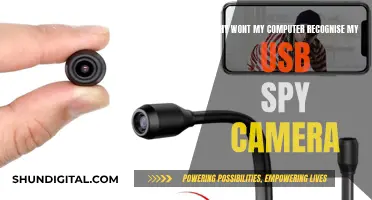
Rangefinder cameras are known for their manual focus capabilities, giving photographers full control over their images. The focusing process involves bringing two images into alignment: one through the viewfinder and a smaller, secondary image. By turning the focus ring, photographers adjust the distance to the object until both images match, achieving perfect focus. This method offers millimeter precision and is particularly effective for static objects or landscapes. While rangefinders lack autofocus, they excel in low-light conditions, producing sharp and well-composed photos even in challenging lighting. Additionally, their compact size, light weight, and quiet operation make them a popular choice for street photography.
| Characteristics | Values |
|---|---|
| Type of camera | Rangefinder |
| Use | Quick, precise focusing |
| Image | Two images of the same subject, one of which moves when a calibrated wheel is turned |
| Focusing | When the two images coincide and fuse into one, the distance can be read off the calibrated wheel |
| Display | Older, non-coupled rangefinder cameras display the focusing distance and require the photographer to transfer the value to the lens focus ring |
| Viewfinder | Rangefinder incorporated into the viewfinder |
| Autofocus | Almost all digital cameras, and most later film cameras, measure distance using electroacoustic or electronic means and focus automatically |
| Rangefinder type | Optical rangefinder |
| Working principle | Triangulation |
| Rangefinder mechanism | Optical rangefinder mechanism |
| Rangefinder coupling | Coupled or uncoupled |
What You'll Learn
- Rangefinder cameras use a separate visual system to show two images of the same subject
- The photographer adjusts a calibrated wheel until the two images become one
- The distance value is then transferred to the lens focus ring
- Rangefinders can be coupled or uncoupled
- Rangefinders can be integrated or sold separately as an accessory

Rangefinder cameras use a separate visual system to show two images of the same subject
Rangefinder cameras are the original mirrorless cameras. They were popular with street photographers because they were smaller and more portable than the bulky film single-lens reflex (SLR) cameras available at the time. They used the same 35mm film as SLRs, but they had a different focusing method that didn't require a mirror.
Rangefinder cameras use a different focusing method called a rangefinder. Instead of looking directly through the lens via a mirror, a rangefinder's viewfinder is an entirely separate visual system mounted as close as possible to the lens. It shows two overlapping images of the same subject. The photographer aligns these images, and the distance—or range—to the subject is calculated (thanks to the parallax effect), allowing the lens to focus.
Most varieties of rangefinder show two images of the same subject, one of which moves when a calibrated wheel is turned. When the two images coincide and fuse into one, the distance can be read off the wheel. Older, non-coupled rangefinder cameras display the focusing distance and require the photographer to transfer the value to the lens focus ring.
Rangefinders can be identified by a split-image inside the eyepiece that can be merged by turning a ring or wheel. The split image may appear as a translucent, overlapping picture or as two halves of a picture, one of which can move horizontally parallel to the other. The split image may show up inside a small patch in the middle of the viewfinder or take up the entire view. A rangefinder patch could be shaped as a rectangle, rhombus, or circle.
Charging Camera Batteries: Strategies for Dead Rising Players
You may want to see also

The photographer adjusts a calibrated wheel until the two images become one
Rangefinder cameras are equipped with a range-finding focusing mechanism that allows photographers to measure the distance of their subject and take photographs that are in sharp focus.
Most rangefinders display two images of the same subject, one of which moves horizontally when a calibrated wheel is turned. The photographer adjusts this wheel until the two images merge into one, at which point the distance can be read off the wheel and transferred to the lens focus ring. This process is known as focusing.
Older, non-coupled rangefinder cameras require the photographer to manually transfer the distance value from the calibrated wheel to the lens focus ring. In contrast, modern rangefinders are coupled to the focusing mechanism, automatically ensuring that the lens is correctly focused when the rangefinder images fuse.
Rangefinder cameras were particularly popular from the 1930s to the 1970s, after which more advanced models were superseded by single-lens reflex (SLR) cameras. Despite this, rangefinder cameras continue to be produced and remain popular among photographers due to their unique advantages, such as compact size, quiet operation, and steady performance.
Samsung S9 Camera: Portrait Mode Available?
You may want to see also

The distance value is then transferred to the lens focus ring
The photographer must manually adjust the lens focus ring to match the calculated distance value. Older, non-coupled rangefinder cameras require the photographer to transfer the distance value to the lens focus ring. In other words, after determining the distance, the photographer must manually adjust the lens focus ring to match that distance.
The process of transferring the distance value to the lens focus ring involves physically turning the focus ring until the two images in the viewfinder align and fuse into a single image. This manual adjustment ensures that the lens is correctly focused on the desired subject.
The photographer's task is to turn the focus ring until the two images in the viewfinder match and overlap, indicating that the lens is now focused on the chosen subject. This process is known as "focusing" and is a critical step in ensuring the final photograph is sharp and clear.
It is worth noting that modern cameras with built-in rangefinders automate this process. In these cases, the lens is automatically focused when the rangefinder images overlap, eliminating the need for manual adjustment by the photographer. However, in the context of older, non-coupled rangefinder cameras, the distance value must be manually transferred to the lens focus ring.
Automatically Numbering in Camera Raw: A Step-by-Step Guide
You may want to see also

Rangefinders can be coupled or uncoupled
On the other hand, an uncoupled rangefinder allows the photographer to measure the distance to the subject and then manually transfer this measurement to the camera's actual distance ring. In other words, the photographer must adjust the split image, read the rangefinder value (distance), and then transfer that value to the lens. Most older, non-coupled rangefinder cameras fall into this category, displaying the focusing distance and requiring the photographer to manually adjust the lens focus ring accordingly. Uncoupled rangefinders are also typically of the split-image type, with the image divided horizontally into two zones, one of which is fixed and the other movable.
Accessory rangefinders, which are separate devices that can be used with almost any camera with a focusing lens, are always uncoupled. The Zeiss Ikon Ikonta is an example of a camera with a coupled rangefinder that is not combined with the viewfinder.
Charging Camera Batteries: Refuel's Quick and Easy Guide
You may want to see also

Rangefinders can be integrated or sold separately as an accessory
Rangefinders can be integrated into the camera or sold separately as an accessory. An accessory rangefinder is always uncoupled, meaning it is not connected to the lens. This means that the photographer must read the output and manually dial it onto the lens.
Rangefinders were first introduced as an accessory in the 1925 Leica I, which popularized the use of accessory rangefinders. The 1932 Leica II and Zeiss Contax I were great successes as 35mm rangefinder cameras. In 1936, the Contax II integrated the rangefinder into the centre of the viewfinder, meaning photographers no longer had to focus through a separate rangefinder eyepiece.
Rangefinders can be identified by a split-image inside the eyepiece, which can be merged by turning a ring or wheel. The split image may appear as a translucent, overlapping picture or as two halves of a picture, one of which can move horizontally. The image is merged when the distance is correct.
Rangefinders are typically lighter, quieter and steadier than SLRs. They are also smaller, as they do not have to work around a viewing mirror. They are also less prone to shake and easier to use with slow shutter speeds.
The Matrix Camera Rig: Capturing Action With Multiple Cameras
You may want to see also
Frequently asked questions
A rangefinder camera is fitted with a rangefinder, which is a range-finding focusing mechanism that allows the photographer to measure the distance of the subject and take photographs that are in sharp focus.
A rangefinder camera focuses by showing two overlapping images of the subject. The photographer then adjusts the focus ring until the two images match up, bringing the subject into focus.
Rangefinder cameras are often lighter, quieter, and more compact than other types of cameras, such as SLRs. They are also steadier since they do not require an SLR mirror to get out of the way when taking a photo, making them less prone to shake.







